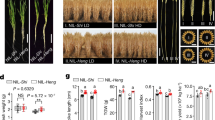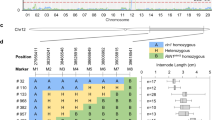Abstract
World wheat grain yields increased substantially in the 1960s and 1970s because farmers rapidly adopted the new varieties and cultivation methods of the so-called ‘green revolution’1,2,3,4. The new varieties are shorter, increase grain yield at the expense of straw biomass, and are more resistant to damage by wind and rain3,4. These wheats are short because they respond abnormally to the plant growth hormone gibberellin. This reduced response to gibberellin is conferred by mutant dwarfing alleles at one of two Reduced height-1 (Rht-B1 and Rht-D1) loci4,5. Here we show that Rht-B1/Rht-D1 and maize dwarf-8 (d8)6,7 are orthologues of the Arabidopsis Gibberellin Insensitive (GAI) gene8,9. These genes encode proteins that resemble nuclear transcription factors and contain an SH2-like10 domain, indicating that phosphotyrosine may participate in gibberellin signalling. Six different orthologous dwarfing mutant alleles encode proteins that are altered in a conserved amino-terminal gibberellin signalling domain. Transgenic rice plants containing a mutant GAI allele give reduced responses to gibberellin and are dwarfed, indicating that mutant GAI orthologues could be used to increase yield in a wide range of crop species.
This is a preview of subscription content, access via your institution
Access options
Subscribe to this journal
Receive 51 print issues and online access
$199.00 per year
only $3.90 per issue
Buy this article
- Purchase on SpringerLink
- Instant access to full article PDF
Prices may be subject to local taxes which are calculated during checkout




Similar content being viewed by others
References
Dyson, T. Population and Food: Global Trends and Future Prospects (Routledge, London, (1996).
Conway, G. The Doubly Green Revolution: Food For All in the 21st Century (Penguin Books, London, (1997).
Evans, L. T. Crop Evolution, Adaptation and Yield (Cambridge Univ. Press, Cambridge, (1993).
Gale, M. D. & Youssefian, S. in Progress in Plant Breeding (ed. Russell, G. E.) 1–35 (Butterworths, London, (1985).
Börner, A., Plaschke, J., Korzun, V. & Worland, A. J. The relationships between the dwarfing genes of wheat and rye. Euphytica 89, 69–75 (1996).
Harberd, N. P. & Freeling, M. Genetics of dominant gibberellin-insensitive dwarfism in maize. Genetics 121, 827–838 (1989).
Winkler, R. G. & Freeling, M. Physiological genetics of the dominant gibberellin non-responsive maize dwarfs, Dwarf8 and Dwarf9. Plant. 193, 341–348 (1994).
Koornneef, M. et al. Agibberellin insensitive mutant of Arabidopsis thaliana. Physiol. Plant. 65, 33–39 (1985).
Peng, J. et al. The Arabidopsis GAI gene defines a signalling pathway that negatively regulates gibberellin responses. Genes Dev. 11, 3194–3205 (1997).
Koch, C. A., Anderson, D., Moran, M. F., Ellis, C. E. & Pawson, T. SH2 and SH3 domains: elements that control interactions of cytoplasmic signaling proteins. Science 252, 668–674 (1991).
Hooley, R. Gibberellins: Perception, transduction and responses. Plant Mol. Biol. 26, 1529–1555 (1994).
Gale, M. D. & Marshall, G. A. The chromosomal location of Gai1 and Rht1 genes for gibberellin insensitivity and semi-dwarfism, in a derivative of Norin 10 wheat. Heredity 37, 283–289 (1976).
Webb, S. E., Appleford, N. E. J., Gaskin, P. & Lenton, J. R. Gibberellins in internodes and ears of wheat containing different dwarfing alleles. Phytochemistry 47, 671–677 (1998).
Fujioka, S. et al. The dominant non-gibberellin-responding dwarf mutant (D8) of maize accumulates native gibberellins. Proc. Natl Acad. Sci. USA 85, 9031–9035 (1988).
Peng, J., Richards, D. E., Moritz, T., Caño-Delgado, A. & Harberd, N. P. Extragenic suppressors of the Arabidopsis gai mutation alter the dose-response relationship of diverse gibberellin responses. Plant Physiol. 119, 1199–1208 (1999).
Silverstone, A. L., Ciampaglio, C. N. & Sun, T.-p. The Arabidopsis RGA gene encodes a transcriptional regulator repressing the gibberellin signal-transduction pathway. Plant Cell 10, 155–169 (1998).
Moore, G., Devos, K. M., Wang, Z. & Gale, M. D. Grasses, line up and form a circle. Curr. Biol. 5, 737–739 (1995).
Di Laurenzio, L. et al. The SCARECROW gene regulates an asymmetric cell division that is essential for generating the radial organization of the Arabidopsis root. Cell 86, 423–433 (1996).
Schumacher, K., Schmitt, T., Rossberg, M., Schmitz, T. & Theres, K. The Lateral Suppressor (Ls) gene of tomato encodes a new member of the VHIID protein family. Proc. Natl Acad. Sci. USA 96, 290–295 (1999).
Chen, X. et al. Crystal structure of a tyrosine phosphorylated STAT-1 dimer bound to DNA. Cell 93, 827–839 (1998).
Becker, S., Groner, B. & Müller, C. W. Three-dimensional structure of the Stat3 homodimer bound to DNA. Nature 394, 145–151 (1998).
Darnell, J. E. J STATs and gene regulation. Science 277, 1630–1635 (1997).
Fütterer, J. & Hohn, T. Translation in plants—rules and exceptions. Plant Mol. Biol. 32, 159–189 (1996).
Peng, J. & Harberd, N. P. Derivative alleles of the Arabidopsis gibberellin-insensitive (gai) mutation confer a wild-type phenotype. Plant Cell 5, 351–360 (1993).
Sambrook, J., Fritsch, E. F. & Maniatis, T. Molecular Cloning: A Laboratory Manual (Cold Spring Harbor Laboratory Press, Cold Spring Harbor, New York, USA, (1989).
Devos, K. M., Dubcovsky, J., Dvorák, J., Chinoy, C. N. & Gale, M. D. Structural evolution of wheat chromosomes 4A, 5A, and 7B and its impact on recombination. Theor. Appl. Genet. 91, 282–288 (1995).
Sudhakar, D. et al. An efficient rice transformation system utilizing mature seed-derived explants and a portable, inexpensive particle bombardment device. Transgenic Res. 7, 289–294 (1998).
Kurata, N. et al. A300-kilobase-interval genetic map of rice including 883 expressed sequences. Nature Genet. 8, 365–372 (1994).
Winkler, R. G. & Helentjaris, T. Dominant dwarfs. Maize Genet. Coop. Newsl. 67, 110–111 (1993).
Kawata, T. et al. SH2 signalling in a lower eukaryote: a STAT protein that regulates stalk cell differentiation in Dictyostelium. Cell 89, 909–916 (1997).
Acknowledgements
We thank S. Cobb, E. Coen, G. Coupland and C. Dean for comments on the manuscript; L.Sayers for help with figures; A. Harvey, D. Lonsdale and T. Dyer for the wheat/maize cDNA/genomic DNA libraries; the International Atomic Energy Agency (Vienna) for mutagenesis; T.Helentjaris for additional mapping and DNA sequencing; T. Sasaki of the Japanese Rice Genome Programme for EST clones; and the BBSRC (Core Strategic Grant to the John Innes Centre; Plant Molecular Biology II; Agricultural Systems Directorate), EU Framework IV and Pioneer Hi-Bred International for funding.
Author information
Authors and Affiliations
Corresponding author
Rights and permissions
About this article
Cite this article
Peng, J., Richards, D., Hartley, N. et al. ‘Green revolution’ genes encode mutant gibberellin response modulators. Nature 400, 256–261 (1999). https://doi.org/10.1038/22307
Received:
Accepted:
Issue Date:
DOI: https://doi.org/10.1038/22307
This article is cited by
-
GRAS gene family in rye (Secale cereale L.): genome-wide identification, phylogeny, evolutionary expansion and expression analyses
BMC Plant Biology (2024)
-
Photosynthesis and radiation use efficiency at anthesis in relation to biomass accumulation and yield in Basmati rice (Oryza sativa L.)
Plant Physiology Reports (2024)
-
Deciphering the genetic architecture of plant height and main shoot length in backcross introgression lines of Sinapis alba + Brassica juncea allohexaploids
Euphytica (2024)
-
Genetic analysis of late-maturity α-amylase in twelve wheat populations
Planta (2024)
-
A mutation in CsDWF7 gene encoding a delta7 sterol C-5(6) desaturase leads to the phenotype of super compact in cucumber (Cucumis sativus L.)
Theoretical and Applied Genetics (2024)



